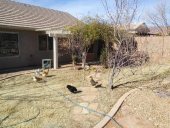



Borderlands Restoration manages a full-service Native Plant Nursery & Seed Lab, providing restoration practitioners & residents in the Madrean Archipelago eco-region with a source of high-quality native plants, seeds, and consulting services.

The Borderlands Mission:
To foster ecological and cultural place-based learning and leadership, restore and support healthy, regenerating water sources and flourishing plant and animal communities, and support prosperous borderland communities by expanding a vibrant restoration economy.






Pearl Sutton wrote:...I saw how to look at buildings, and see "what patterns are working here, which are not, and why?" and I have used that to design our OWN patterns for ourselves. I took some of his patterns, some intact, some modified, and figured out some of my own, and used them...
...To me the best part of the book was the CONCEPT "there are patterns, look for them, find your OWN." ...seeing what patterns we we responding to when we loved or hated a feature or a whole building. I also took the pattern idea into our base permaculture layout, made sure the patterns that matter to us are designed into the landscape NOW, before the work on the dirt begins, so when it's farther along it will be growing up to be OUR patterns in the trees and land (as well as base permaculture patterns like "here be swales") and not the ones other people want or need...
....one of my MAJOR patterns that other people call "a godforsaken mess" is "tools within my reach" I use a lot of tools, in all my things I do, from computers and saws, to sewing machines, medical stuff, and a lot of kitchen supplies. If it's not within reach, I make it that way, whether it makes a "mess" or not, I'm a master of the "pile of chaos" system of living... Learning JUST that one thing about myself was worth the price of the book....
....I cried when I read it, there is SO much potential for neat, human friendly designs, and it's not common in this culture. I read his comments about what it would look like if it's allowed to continue like it was headed (70's I think, when it was written) and then I looked as I drove around, saw soul dead strip malls, suburbs not made for humans... And I cried, for what we COULD have, versus what we do.



Zach Weiss wrote:
It is very important to note that Sepp is only using very rot resistant species such as Black Locust and Larch, this is the primary reason that these earth stables last so long. I would expect a structure like this to last around 50 years, potentially much longer in drier climates.

R Ranson wrote:
tel jetson wrote:
R Ranson wrote:It's very thick jelly in a jar.
This website http://kakishibuusa.com/ has instructions in how to use it as paint...
Kakishibu Paint ~ "Nu-ri" - Care Points -
1. The color will be darker after the time passes, especially the surface with sunlight directly. It is better to make little lighter than you think.
2. Kakishibu will have chemical reaction with "Steel". Please do NOT use containers made by steel.
3. In case you have small air bubble during the paint, please take off with fabric.
4. There is no effect for "waterproof" right after you paint. Please make it dry out, and Kakishibu creates natural water proof effect by being oxidized in the air.
5. Kakishibu will be firmed like jelly by fermentation in the bottle. Can not keep for long term.